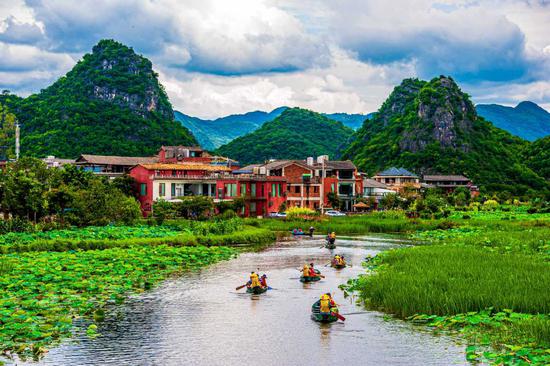Ethnic region attracts visitors with all-for-one tours

Tourists row boats along a river in Wenshan Zhuang and Miao autonomous prefecture, Yunnan province, on July 7. (Photo provided to China Daily)
Zhou Yichang, a resident of Guangnan county in the Wenshan Zhuang and Miao autonomous prefecture of Yunnan province, said she is proud of her native place, which produces cash crops and attracts tourists.
Green is the distinctive feature of Wenshan, said Zhou, who is chairwoman of Lingya Original Dendrobium Technology Co Ltd.
The region's treasures include the double-petaled lotus, the peach blossom jellyfish — a living fossil in water, and the canopy tree, known as the "giant panda" of the plant world there.
The earliest known leaf fossil of "Elegans Folium", a primordial plant, was also discovered here, along with the country's largest and most intact scaly tree forest, she said.
The region also grows over 60 varieties of traditional Chinese medicinal herbs.
All these, plus its karst backdrop, ethnic culture, leisure and wellness, as well as culinary attractions, are helping to draw in more visitors, she said.
At the Liulangcheng fairyland of medicinal herbs in Guangnan, where visitors can see, taste, and experience the many facets of the Dendrobium orchid, local homestays are almost always fully booked, especially during holidays, Zhou said.
Zhou is well-known locally, as her professional cooperative of farmers has led over 1,300 local households to businesses, adding an average annual income of more than 23,000 yuan ($3,180) to each family.
Her business strategy is an "integration of three industries", helping people to land jobs nearby.
During this year's National Day holiday, Wenshan witnessed 1.44 million tourist trips, gaining over 1.29 billion yuan in tourist revenue, marking year-on-year increases of 12.2 percent and 19.8 percent, respectively, said Wang Ling, deputy director of the Wenshan Culture and Tourism Bureau.
She said the prefecture is integrating its karst scenes, ethnic culture, leisure and wellness as well as culinary prowess to deepen all-for-one tourism in the region, which administers seven counties and one city in southeastern Yunnan.
The local karst landscape is stunning, and the countryside featuring mountains and clear waters can leave visitors in awe.
Citing Puzhehei as an example, Jie Qiong, a local photographer, said the national 5A-level scenic area features 312 isolated peaks scattered across the area, with 83 karst caves of various forms, and 54 interconnected lakes.
"Its 2,700 hectares of wild lotus and 4,500 hectares of highland karst wetlands are also a special draw," Jie said.
Meanwhile, with 11 ethnic groups coexisting in harmony in Wenshan to create a vibrant cultural mosaic, Jie said its bronze drum culture, rice-growing expertise, Poya culture, the local woodblock printing and the China-Vietnam Folk Song Festival can provide tourists with year-round festivals, songs and dances.
Furthermore, leisure and wellness tours immersed in green ecology are also a vogue in Wenshan, while its cuisine lures visitors, Zhou said.
The Zhuang "flower rice", herb-flavored chicken and wine, chrysanthemum duck, Dendrobium feasts and lotus feasts partially represent the region's rich medicinal and culinary culture, offering endless possibilities for gastronomy.
"We hope that the local A-level scenic areas can help drive the growth of Wenshan's tourism industry, particularly through a model where tourism promotes rural vitalization, thus enabling the local residents to share the benefits and dividends of tourism growth," Wang said.
